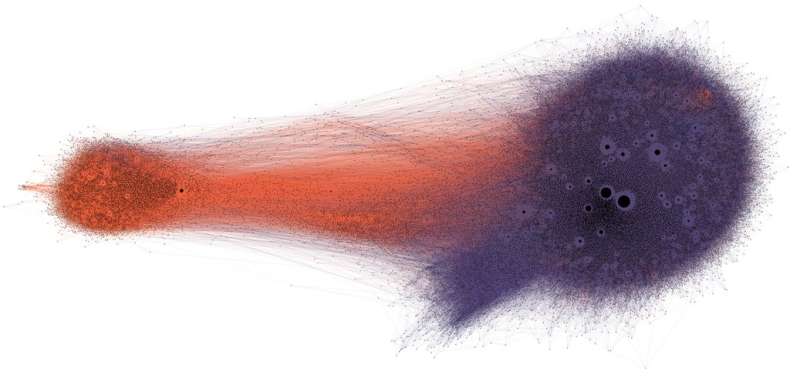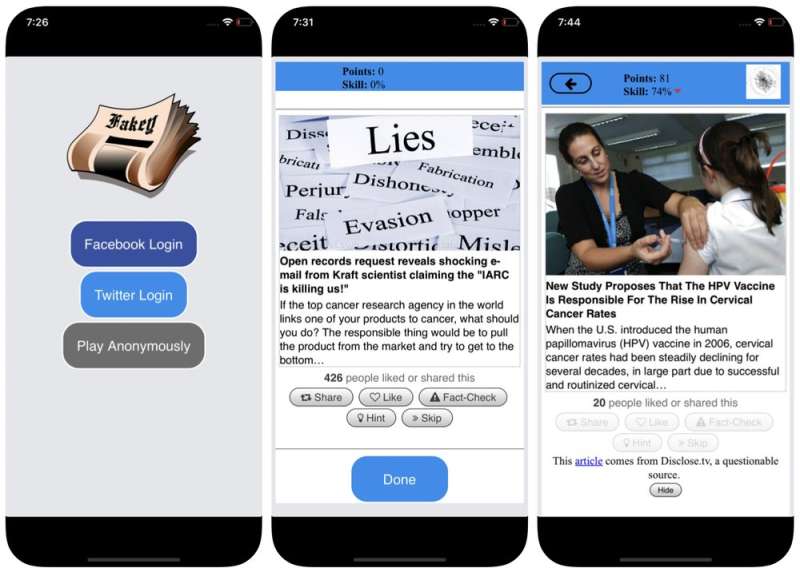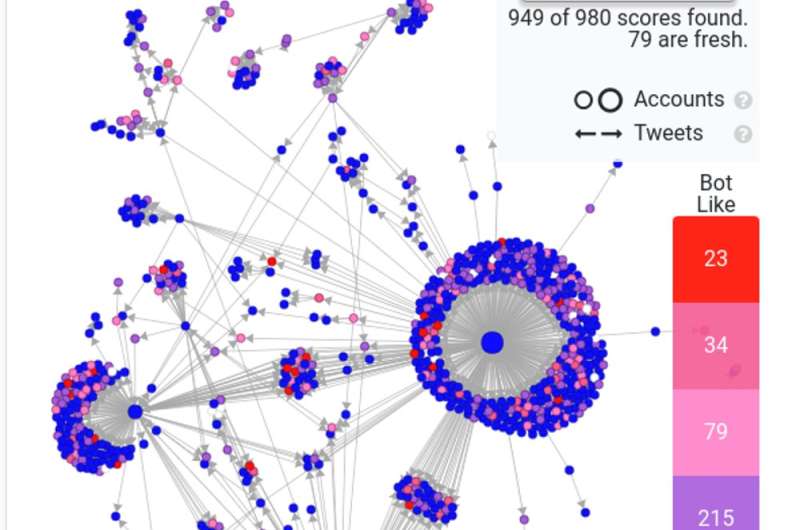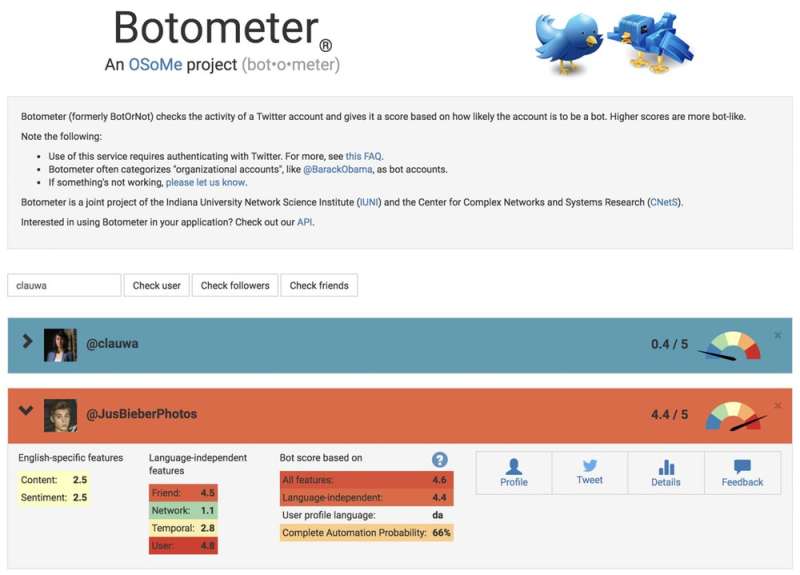Misinformation and biases infect social media, both intentionally and accidentally

Social media are among the and across the world. Yet users are exposed to content of questionable accuracy, including , , , and even .
It's not surprising that there's so much disinformation published: Spam and online fraud , and government and political propaganda yield . But the fact that suggests that people and the algorithms behind social media platforms are vulnerable to manipulation.
Our research has identified three types of bias that make the social media ecosystem vulnerable to both intentional and accidental misinformation. That is why our at Indiana University is building to help people become aware of these biases and protect themselves from outside influences designed to exploit them.
Bias in the brain
Cognitive biases originate in the way the brain processes the information that every person encounters every day. The brain can deal with only a finite amount of information, and too many incoming stimuli can cause . That in itself has serious implications for the quality of information on social media. We have found that steep competition for users' limited attention means that – even when people prefer to share high-quality content.
To avoid getting overwhelmed, the brain uses a . These methods are usually effective, but may also when applied in the wrong contexts.
One cognitive shortcut happens when a person is deciding whether to share a story that appears on their social media feed. People are , even though that's not a good indicator of an article's accuracy. Much more important is .
To counter this bias, and help people pay more attention to the source of a claim before sharing it, we developed , a mobile news literacy game (free on and ) simulating a typical social media news feed, with a mix of news articles from mainstream and low-credibility sources. Players get more points for sharing news from reliable sources and flagging suspicious content for fact-checking. In the process, they learn to recognize signals of source credibility, such as hyperpartisan claims and emotionally charged headlines.
Bias in society
Another source of bias comes from society. When people connect directly with their peers, the social biases that guide their selection of friends come to influence the information they see.
In fact, in our research we have found that it is possible to by simply looking at the partisan preferences of their friends. Our analysis of the structure of these found social networks are particularly efficient at disseminating information – accurate or not – when .
The tendency to evaluate information more favorably if it comes from within their own social circles creates "" that are ripe for manipulation, either consciously or unintentionally. This helps explain why so many online conversations devolve into .

To study how the structure of online social networks makes users vulnerable to disinformation, we built , a system that tracks and visualizes the spread of content from low-credibility sources, and how it competes with fact-checking content. Our analysis of the data collected by Hoaxy during the 2016 U.S. presidential elections shows that Twitter accounts that shared misinformation were from the corrections made by the fact-checkers.
When we drilled down on the misinformation-spreading accounts, we found a very dense core group of accounts retweeting each other almost exclusively – including several bots. The only times that fact-checking organizations were ever quoted or mentioned by the users in the misinformed group were when questioning their legitimacy or claiming the opposite of what they wrote.
Bias in the machine
The third group of biases arises directly from the algorithms used to determine what people see online. Both social media platforms and search engines employ them. These personalization technologies are designed to select only the most engaging and relevant content for each individual user. But in doing so, it may end up reinforcing the cognitive and social biases of users, thus making them even more vulnerable to manipulation.
For instance, the detailed advertising tools built into many social media platforms let disinformation campaigners exploit by to people who are already inclined to believe them.
Also, if a user often clicks on Facebook links from a particular news source, Facebook will . This so-called "" effect may isolate people from diverse perspectives, strengthening confirmation bias.

Our own research shows that social media platforms expose users to a less diverse set of sources than do non-social media sites like Wikipedia. Because this is at the level of a whole platform, not of a single user, we call this the .
Another important ingredient of social media is information that is trending on the platform, according to what is getting the most clicks. We call this , because we have found that an algorithm designed to promote popular content may negatively affect the overall quality of information on the platform. This also feeds into existing cognitive bias, reinforcing what appears to be popular irrespective of its quality.
All these algorithmic biases can be manipulated by , computer programs that interact with humans through social media accounts. Most social bots, like Twitter's , are harmless. However, some conceal their real nature and are used for malicious intents, such as or falsely , also called "astroturfing." We found in the run-up to the 2010 U.S. midterm election.
To study these manipulation strategies, we developed a tool to detect social bots called . Botometer uses machine learning to detect bot accounts, by inspecting thousands of different features of Twitter accounts, like the times of its posts, how often it tweets, and the accounts it follows and retweets. It is not perfect, but it has revealed that as many as .
Using Botometer in conjunction with Hoaxy, we analyzed the core of the misinformation network during the 2016 U.S. presidential campaign. We found many bots exploiting both the cognitive, confirmation and popularity biases of their victims and Twitter's algorithmic biases.
These bots are able to construct filter bubbles around vulnerable users, feeding them false claims and misinformation. First, they can attract the attention of human users who support a particular candidate by tweeting that candidate's hashtags or by mentioning and retweeting the person. Then the bots can amplify false claims smearing opponents by retweeting articles from low-credibility sources that match certain keywords. This activity also makes the algorithm highlight for other users false stories that are being shared widely.

Understanding complex vulnerabilities
Even as our research, and others', shows how individuals, institutions and even entire societies can be manipulated on social media, there are left to answer. It's especially important to discover how these different biases interact with each other, potentially creating more complex vulnerabilities.
Tools like ours offer internet users more information about disinformation, and therefore some degree of protection from its harms. The solutions will , though there will probably be some technical aspects to them. But they must take into account of the problem.
Editor's note: This article was updated on Jan. 10, 2019, to remove a link to a study that has been retracted. The text of the article is still accurate, and remains unchanged.
Provided by The Conversation
This article was originally published on . Read the .![]()




















